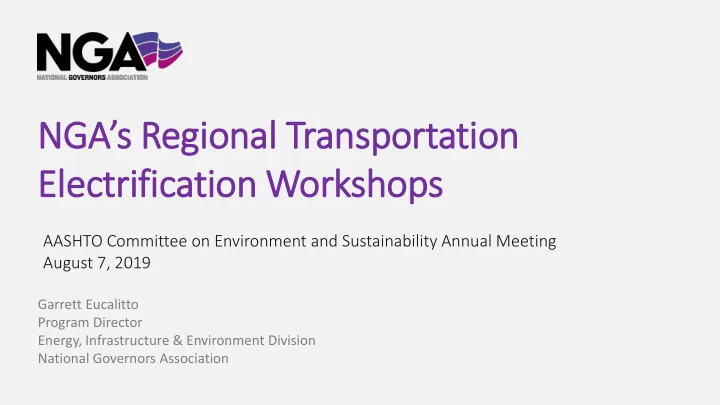

NGA’s R Regiona nal Transpo portation n El Electri ctrificati tion W Work rksh shops AASHTO Committee on Environment and Sustainability Annual Meeting August 7, 2019 Garrett Eucalitto Program Director Energy, Infrastructure & Environment Division National Governors Association
What is N NGA? A? Founded in 1908, the National Governors Association (NGA) is the collective voice of the nation’s governors. Our members are the governors of the 55 states, territories and commonwealths. NGA provides governors and their staff with services that range from representing states on Capitol Hill and before the Administration to developing and implementing innovative solutions to public policy challenges through the NGA Center for Best Practices.
Energy, Infrastructure and Environment (EIE) Division Resource for Governors o Research & Policy Analysis o Technical Assistance o Convenings and Workshops o https://www.ng nga. a.org/bestpract ctice ices/di divis isio ions ns/eie ie/
Transportation Technologies o of F Focus RIDE-HAILING AND ELECTRIC VEHICLES UAV/DRONES CONNECTED AND CAR-SHARING v AUTONOMOUS VEHICLES
Why Go Gover ernor ors Ar Are Int nterested
LOWERING & SHIFTING EMISSIONS Benefits f from ELECTRICITY MARKET BENEFITS Electrified Transpor ortati tion on MINIMIZING HOUSEHOLD EXPENSES REDUCING PETROLEUM DEPENDENCE
Where We We We Went
State S Succ ccess S Storie ies
State Success Stories VW Settlement funds being deployed Transit fleet conversions nationwide Regional charging corridor efforts emerging, and FHWA ready to help Time-of-use rates are helping to smooth energy demand
State P e Polici cies es to Encou ourage E EVs
State EV Incentives State Incentive California $2,500 EV rebate, up to $4,500 based on income eligibility Connecticut $2,000 EV rebate Colorado $5,000 tax credit Delaware $3,500 EV rebate Louisiana $2,500 income tax credit Maryland $3,000 excise tax credit for new EV purchases Massachusetts $1,500 EV rebate New York $2,000 EV rebate Oregon $2,500 EV rebate Pennsylvania $1,750 EV rebate
Calif iforn rnia • $2,500 EV purchase rebate, can increase to $4,500 given income eligibility • 5 Million EVs on the road by 2030 – 2018 Executive Order • ZEV multi-state Task Force – mandates 1 million EVs on the road by 2023 • Many utilities offer EVs and charging rebates • Incorporates EVSE into building standard codes
Colorad ado • Offers a $5,000 tax credit for eligible EV purchases – the highest tax credit of any state • Offers grants for EVs and EVSE – 80 percent of EV cost, up to $8,260, 80 percent of EVSE cost, up to $6,260. • Governor Polis issued his first Executive Order to advance EV adoption. Revises use of VW funds to focus investment on transportation electrification. • 940,000 EVs on the road by 2040.
Co Connect cticu cut • Up to $2,000 EV rebate – depends on battery range • Provides funding for 50-100% of EVSE costs (up to $10,000 per site) depending on program alignment • CT Green Bank offers low-interest loans up to $30,000 for EV buyers. Also available for EVSE purchases • New registration fee for all vehicles to help pay for the CHEAPR program
Massa ssachuse setts • $1,500 EV purchase rebate* • Fleet EV incentive for up to $7,500 and mandate for 50% hybrid or electric vehicles by 2018. • Multi-Unit Dwelling charging grants for 60% of costs, up to $50,000 • Other non-residential facilities may receive charging equipment grants for 80% of costs, up to $50,000
Challen enges es Fac acing t the States
Challenges Facing the States How to prioritize limited funding? EV or EVSE incentives first? How can consumers become more aware about EV incentives? How do you structure incentive programs to encourage dealers?
Challenges Facing the States What is the appropriate financing mechanism to generate contributions to infrastructure funding streams? What is the “right” EVSE ownership model? How can state fleets be converted easily, and how should charging infrastructure be handled?
Challenges Facing the States How can states incorporate equity into incentive structures? How can we better coordinate b/t Energy, Natural Resources, and DOT staff? Rest Areas and What is the impact on state revenue?
State-Impos osed ed E Elec ectr tric Veh ehicle icle F Fees ees
Th Than ank Y You @NatlGovsA sAsso soc Garre rrett Eu Eucalit litto, Pro , Program D Dire irector @GEu Eucali litto Energ Ene rgy, Inf nfra rastructure a and nd En Enviro ironment nt D Div ivis ision #WeTheStates geucalit itto@ o@nga ga.org org
Recommend
More recommend